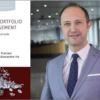IP Management applied in practice: Interview with MIPLM graduate Trond Ramsvik
The IP-Management program at CEIPI is by far the most successful executive management program in IP in Europe. Since 2005, CEIPI has offered a comprehensive IP Management education, for which it develops case studies with C-Level executives and heads of IP from industry to prove the success of its methods, skills and knowledge. The students and lecturers of the program come from industry, private practice, and institutions from around the globe. The IP-Management education at CEIPI is modular, ranging from University Certificates, over the University Diploma Intellectual Property Business Administration (DU IPBA), the Master of Intellectual Property Law and Management (MIPLM, Master (II), LLM) to the PhD in IP management. Here is an interview with Trond Ramsvik, who graduated the MIPLM in 2024 and works with AWA Norway.
IP business academy: What is your professional background and how did you come to the interesting area of IP and IP Management?
Trond Ramsvik: I am currently working as a European Patent Attorney in a private practice in an IP Law firm. After my PhD dissertation, I started working as a researcher in different research institutes, such as CERN European Organization for Nuclear Research. I then decided to return to my home country. While searching for job with different key words, the term “Patent attorney” popped up, that sounded exciting. Since 2007, I am in this interesting field of Intellectual Property. As a patent attorney you are to give a high quality advice and services to companies. One needs to understand their challenges and opportunities for reaching their goals. So throughout my career I felt a need to deepen my knowledge in IP management. I heard about the IP Management course from one of my colleagues and decided to apply for the same.
IP business academy: How did your studies at the MIPLM expand your knowledge about IP management?
Trond Ramsvik: A primary responsibility of a patent attorney is to get status reports of a current situation of R&D and guide them to secure their IP most effectively at the given moment. My studies have taught me that our advice can provide significant value for a company if we demonstrate how we integrate IP in the daily operations, as that can serve as a powerful tool to strengthen the competitive advantage. This course not only equipped me with comprehensive understanding of IP but also deepened the grasp of business language. Before this course, I had grasp on technical aspect, now I have grasp on terms of business as well.
IP business academy: How has taking the masters course help you grow in your career? Can you give us some examples or situations where the knowledge of the MIPLM has really help you?
Trond Ramsvik: It is very crucial to understand the integration of IP within business model. The course has significantly added this understanding to my expertise. I can now have more detailed analysis and discussions with clients, and can consult with them to develop more robust IP strategies. The course provides confidence to me and my clients that my advice can actually provide real value for the company.
IP business academy: Who would you recommend to take an IP Management course at CEIPI?
Trond Ramsvik: Oh!! Many!! Everyone who wants to expand their knowledge on IP management and wants to deal with IP in the bigger business context can profit from the course. It is helpful for members of an In-house IP department and also those who are working in R&D, marketing, or are at any kind of decision making position. It is also vital for external counsels as a better understanding of the business needs of the clients. For an external counsel like me, it is crucial to understand the IP challenges within companies and to provide them with informed and more robust management advice.
IP business academy: Do you think IP management and knowledge/skills from the MIPLM will become more important and why?
Trond Ramsvik: Oh, absolutely!!
At the start of the digital transformation and converging industries, the challenges and complexity of IP management have gone up in recent years and I don’t certainly believe that this increase will slow down in near future. For example, due to the integration of industry 4.0 technologies in modern cars, risk management can now involve hundreds of patent rights all representing a threat of future infringements suits. That necessitates to go beyond FTO and towards Freedom of Action, i.e. focusing more on reducing the consequences of possible infringement claims.
IP business academy: Talking now about IP strategy development, many start-ups are struggling with limited funding and limited resources in the beginning. In your experience, how do you think they should prioritize protection of their IP assets?
Trond Ramsvik: Many of my clients, not only start-ups but also small scale enterprises, deal with economic challenges. In my experience, many tech companies, especially start-ups have inadequate control of IP resources that could be transformed into valuable IP assets. Hence, I believe the first step is talking to the management and R&D to get an IP asset overview. And once this is done, these assets must be properly sorted and categorized. The categories may be based on importance according to the company goals and types of IP protection such as Patent, Trade Marks, Design and Trade Secret.
In my experience, when asset overview is done, what is revealed is of much more value than what the start-up owners thought in the beginning. Mostly working with Oil and Gas industry, I have experienced that recently more and more companies are trying to get into the rapidly emerging industry of renewables, and lots of the attempts are made by start-ups. The first choice in IP assets of these start-ups is Patents and Trade Secrets. The Trade Secret is linked to negative know how, meaning all the trial and fails experienced by the R&D team in a product development. When a product is launched, which typically is huge and very expensive, a lot of creative but failed attempts are laid that needs to be protected by trade secret, otherwise their competitor can achieve a significant “short-cut” in their R&D efforts. So Trade Secret, to protect that negative know how, is crucial for start-ups. Of course, to patent commercial products remains a base for further development and strengthens their competitiveness.
IP business academy: If we focus more on Patents, between a patent application for a start-up and a Multi-National Company (MNC), how do you decide on the scope for each of them?
Trond Ramsvik: Well, the choice of scope is often closely related to the financial backbone of companies. In general it is a good practice to file a comprehensive patent application with a broad scope, where a comprehensive patent application is drafted allowing flexibility to file multiple divisional applications. While a start-up tries to protect a core invention with a single or a few patent applications, an MNC has the financial means to start with a very broad protection including different components and methods, in addition to the core invention, in a single patent application.
Also, not only broadness but an ability to create uncertainty for the competitors is important. For example, if I write a comprehensive patent application, my client not only has a possibility to get valuable patent rights, but such broad application, with possibility of multiple divisional patent applications and ability to go for extended prosecution, can also create a considerable uncertainty in a market and to the competitors, because till the grant of the patent application, the competitors are not sure what they can infringe.
Hence, in my opinion, it is quite a difference in what a start-up can achieve and in what a MNCs can achieve in terms of scope. Unfortunately.
About the interviewer:
 Poorti (Vyas) Joshi has a strong foundation in electronics and communications engineering and specialized training in Intellectual Property Law. Her expertise involves leading initiatives that harness technology for improved patent drafting and prosecution processes. The ever changing landscape of technologies and new additions have kept her motivated to be adaptable and analytical. As a Patent Professional, she deals with patent applications in different engineering fields. Starting from scrutinizing patentable ideas, her experience includes drafting of patent specifications for patent applications in different jurisdictions, for a wide variety of clients, starting from individual inventors and startups to multinational companies. Her expertise also includes preparing prosecution strategies and responses to examination reports for patent applications in different jurisdictions. Being a registered Patent Agent (India), she represents clients before the Patent Office in India. Her additional skills include IP strategy development for national and international filings for startups and SME.
Poorti (Vyas) Joshi has a strong foundation in electronics and communications engineering and specialized training in Intellectual Property Law. Her expertise involves leading initiatives that harness technology for improved patent drafting and prosecution processes. The ever changing landscape of technologies and new additions have kept her motivated to be adaptable and analytical. As a Patent Professional, she deals with patent applications in different engineering fields. Starting from scrutinizing patentable ideas, her experience includes drafting of patent specifications for patent applications in different jurisdictions, for a wide variety of clients, starting from individual inventors and startups to multinational companies. Her expertise also includes preparing prosecution strategies and responses to examination reports for patent applications in different jurisdictions. Being a registered Patent Agent (India), she represents clients before the Patent Office in India. Her additional skills include IP strategy development for national and international filings for startups and SME.



